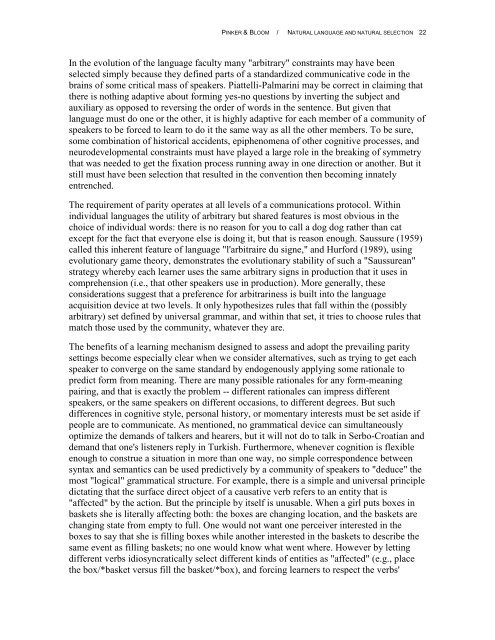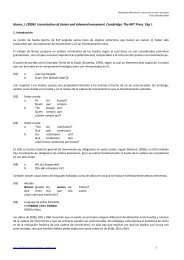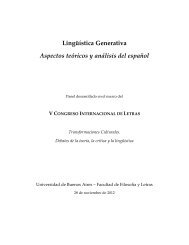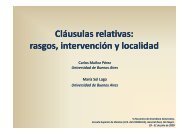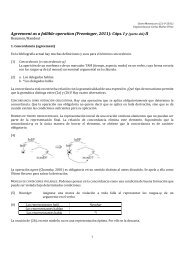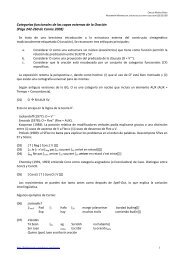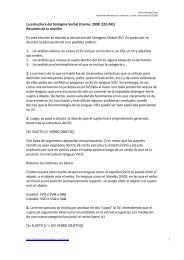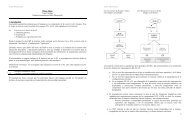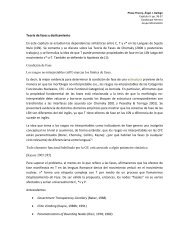Pinker - Bloom - NATURAL LANGUAGE AND NATURAL SELECTION
Pinker - Bloom - NATURAL LANGUAGE AND NATURAL SELECTION
Pinker - Bloom - NATURAL LANGUAGE AND NATURAL SELECTION
Create successful ePaper yourself
Turn your PDF publications into a flip-book with our unique Google optimized e-Paper software.
PINKER & BLOOM / <strong>NATURAL</strong> <strong>LANGUAGE</strong> <strong>AND</strong> <strong>NATURAL</strong> <strong>SELECTION</strong> 22<br />
In the evolution of the language faculty many "arbitrary" constraints may have been<br />
selected simply because they defined parts of a standardized communicative code in the<br />
brains of some critical mass of speakers. Piattelli-Palmarini may be correct in claiming that<br />
there is nothing adaptive about forming yes-no questions by inverting the subject and<br />
auxiliary as opposed to reversing the order of words in the sentence. But given that<br />
language must do one or the other, it is highly adaptive for each member of a community of<br />
speakers to be forced to learn to do it the same way as all the other members. To be sure,<br />
some combination of historical accidents, epiphenomena of other cognitive processes, and<br />
neurodevelopmental constraints must have played a large role in the breaking of symmetry<br />
that was needed to get the fixation process running away in one direction or another. But it<br />
still must have been selection that resulted in the convention then becoming innately<br />
entrenched.<br />
The requirement of parity operates at all levels of a communications protocol. Within<br />
individual languages the utility of arbitrary but shared features is most obvious in the<br />
choice of individual words: there is no reason for you to call a dog dog rather than cat<br />
except for the fact that everyone else is doing it, but that is reason enough. Saussure (1959)<br />
called this inherent feature of language "l'arbitraire du signe," and Hurford (1989), using<br />
evolutionary game theory, demonstrates the evolutionary stability of such a "Saussurean"<br />
strategy whereby each learner uses the same arbitrary signs in production that it uses in<br />
comprehension (i.e., that other speakers use in production). More generally, these<br />
considerations suggest that a preference for arbitrariness is built into the language<br />
acquisition device at two levels. It only hypothesizes rules that fall within the (possibly<br />
arbitrary) set defined by universal grammar, and within that set, it tries to choose rules that<br />
match those used by the community, whatever they are.<br />
The benefits of a learning mechanism designed to assess and adopt the prevailing parity<br />
settings become especially clear when we consider alternatives, such as trying to get each<br />
speaker to converge on the same standard by endogenously applying some rationale to<br />
predict form from meaning. There are many possible rationales for any form-meaning<br />
pairing, and that is exactly the problem -- different rationales can impress different<br />
speakers, or the same speakers on different occasions, to different degrees. But such<br />
differences in cognitive style, personal history, or momentary interests must be set aside if<br />
people are to communicate. As mentioned, no grammatical device can simultaneously<br />
optimize the demands of talkers and hearers, but it will not do to talk in Serbo-Croatian and<br />
demand that one's listeners reply in Turkish. Furthermore, whenever cognition is flexible<br />
enough to construe a situation in more than one way, no simple correspondence between<br />
syntax and semantics can be used predictively by a community of speakers to "deduce" the<br />
most "logical" grammatical structure. For example, there is a simple and universal principle<br />
dictating that the surface direct object of a causative verb refers to an entity that is<br />
"affected" by the action. But the principle by itself is unusable. When a girl puts boxes in<br />
baskets she is literally affecting both: the boxes are changing location, and the baskets are<br />
changing state from empty to full. One would not want one perceiver interested in the<br />
boxes to say that she is filling boxes while another interested in the baskets to describe the<br />
same event as filling baskets; no one would know what went where. However by letting<br />
different verbs idiosyncratically select different kinds of entities as "affected" (e.g., place<br />
the box/*basket versus fill the basket/*box), and forcing learners to respect the verbs'


